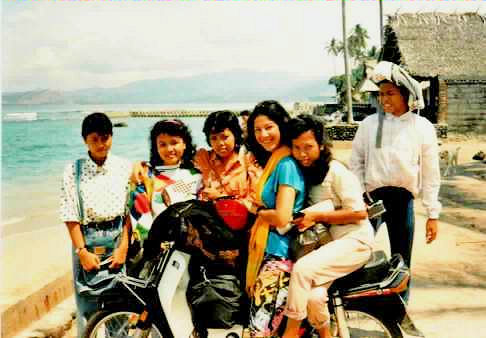After the end of her studies in France (dipl. Licence es Lettres, Paris III Sorbonne), in 1978, she travelled to South India, following a “call of the soul” that she felt since her childhood for the land of philosophers, yogis and myths.
“It was a trip of necessity: I needed to find the answers to the question who I finally am, what do I finally want? Do I really want what I’m doing or are they other people’s choices and I mistakenly think that I was the one who chose to do them?” Her traveling companion was Frenchman Jean-Noel Dervin, who shared the same spiritual quest, and who was to become her first husband. |
|
It was a difficult trip:
“Difficult because we didn’t know whether the next evening I would have a place to sleep, whether I’d find something to eat, whether I’d have to face illnesses that plague foreigners unused to the climate. India is not France”
They went through Pakistan, making a stop at the Kailash valley, to see the population that traces its ancestry to Alexander the Great. From there they crossed to India, down to Madras (today’s Chennai), in South India, the centre for Bharata Natyam dance. |
 |
 |
In a simple room outside the town (that she had to reach on bike), with a mattress on the floor, a mosquito net and a little kerosene stove, her daily life was taken up by hard work, as she took dance and yoga lessons at the same time. |
For three years she was trained in the art of Bharata Natyam with the most distinguished teachers, such as
V.P. Dhananjayan êáé Shanta Dhananjayan, Kalanidhi
Narayanan and Adyar Lakshman.
She studied Carnatic music with Adyar Lakshman and T.K. Padmanabhan: especially song, rhythm (tallams), the art of rhythmic syllables accompanying dance (sholus) and the execution of rhythms on the “tata-kari”, a small xylophone. .
|
 |
 |
She is a graduate of the Indian Dance Academy «Bharata Kalanjali» and the «Abhinaya Sudha» in Chennai (Madras), where, on April 24, 1983, she gave her “arangetam” (first public performance) at the Anantapadmanabha Swami Temple in Adyar.
She was one of the first 20th century dancers to dance again in a temple precinct, after the long prohibition.
“I was so very anxious, that there and then, I swore never to appear in public any more! Generally speaking, my goal in studying the dance was not at all to become a performer. Little by little, however, I got used to it.”
She also danced in the famous Chidambaram temple (picture below). |

In India, Leda studied yoga, theory and practice, delving into the ancient texts of Indian philosophy. She is a graduate of the Õoga Research Institution «Kaivalya Dhama» of Lonavla and was a pupil of some of the greatest yogis and sages of our age.
Her teachers in France were sri Rocketti, Arnaud Desjardins, (France), Leopoldo Chariars, (Argentina), Baba Khan (Egypt), In India, swami Satyananda, B.K.S Iyengar, T.K.V. Desikatchar, sri Chandra Swami (See also the Teachers section).
Her goal in that difficult but fascinating period was internal autonomy, regardless of external circumstances.
“I lived those years as if in a deep tunnel, to emerge liberated, because through those studies I discovered truth and light”.
That was when she changed her surname from Seitanidou to Shantala. As she herself says, it was because as an artist she felt the need to differentiate her social life from her stage persona. Leda is the social person, and her roots are in Greece. Shantala is the dancer, who was born in India.
“Bharata Natyam changed my whole life. It was like a new birth, a new personality. This dance was not given to me by Greece. To mirror this change inside me, I gave myself a new name”.
A name coming from Sanskrit word shanti (meaning peace, as her second Greek name, Irene)
“Indians believe that the sounds of our name influence our whole personality. I already had L and S, I found a name incorporating those two sounds”.
Shantala is also an illustrious name, the name of a Hoysala queen of the 13th century, who also was a great dancer. Lastly, it may be no coincidence that tala is rhythm. In that sense, Shantala may be the one who finds peace through rhythm. |





